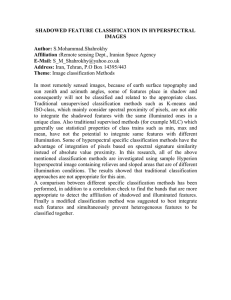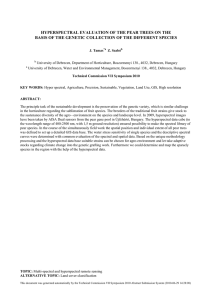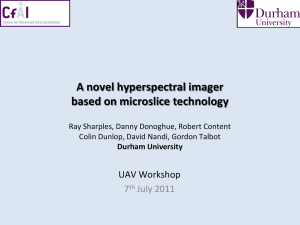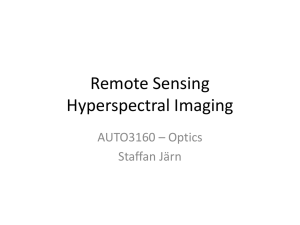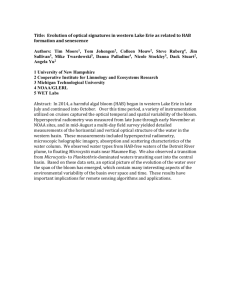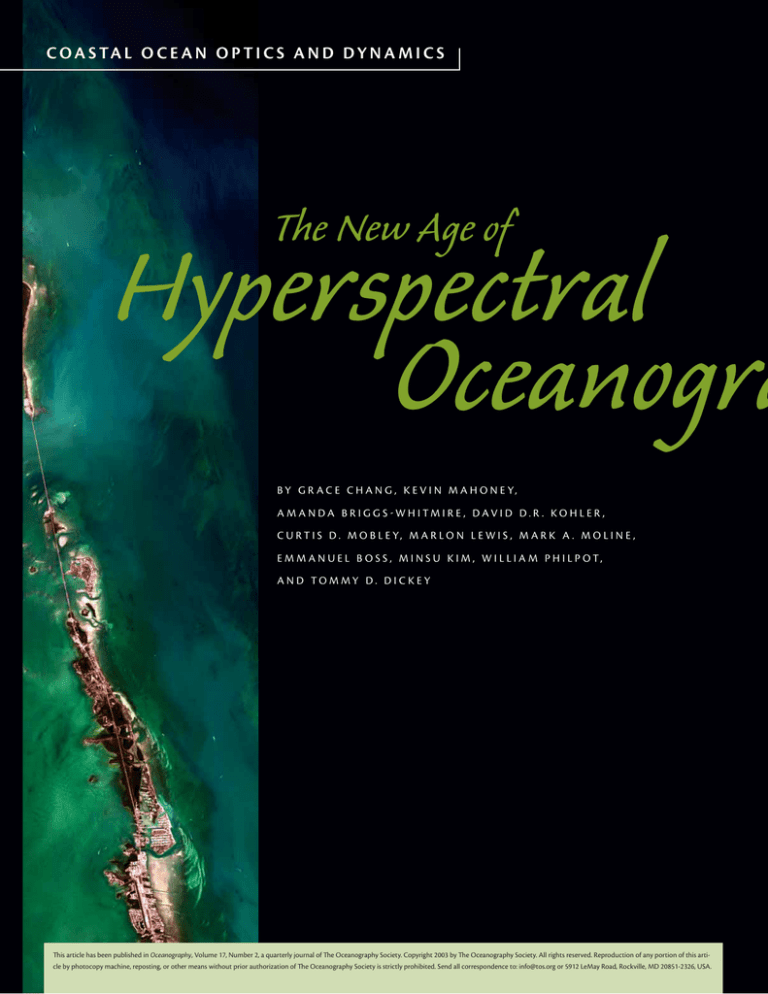
C O A S TA L O C E A N O P T I C S A N D D Y N A M I C S
The New Age of
Hyperspectral
Oceanogra
B Y G R A C E C H A N G , K E V I N M A H O N E Y,
A M A N DA B R I G G S W H ITM I R E , DAV I D D. R . KO H L E R ,
C U R T I S D . M O B L E Y, M A R L O N L E W I S , M A R K A . M O L I N E ,
E M M A N U E L B O S S , M I N S U K I M , W I L L I A M P H I L P O T,
AND TOMMY D. DICKEY
been published in Oceanography,
Volume 17, Number 2, a quarterly journal of The Oceanography Society. Copyright 2003 by The Oceanography Society. All rights reserved. Reproduction of any portion of this artiJune 2004
16This article hasOceanography
cle by photocopy machine, reposting, or other means without prior authorization of The Oceanography Society is strictly prohibited. Send all correspondence to: info@tos.org or 5912 LeMay Road, Rockville, MD 20851-2326, USA.
aphy
A multispectral optical sensor collects data
coastal and open-ocean studies. Advances in
at select wavebands or channels. An example
computer technology in the last decade have
is the Sea-viewing Wide-Field-of-view Sen-
enabled more rapid processing of hyperspec-
sor (SeaWiFS) ocean color satellite, which
tral data and greatly improved the storing
measures eight wavebands between 402 and
and archiving capability of these large, and
885 nm (20-40 nm bandwidth with peaks
often difficult-to-manage data sets.
centered around 412, 443, 490, 510, 555, 670,
Hyperspectral technology has expanded
765, and 865 nm). Optical oceanographers
from hand-held radiometers to submerged
have been using multispectral sensors since
sensors for measurements of inherent op-
1
the 1980s with great success .
A hyperspectral sensor gives continuous
tical properties (IOPs), optical properties
that depend on only the aquatic medium
spectral coverage over a broad wavelength
itself (e.g., absorption and scattering; Mo-
range [at least over visible wavelengths,
bley, 1994) and apparent optical properties
and preferably from near ultraviolet (UV)
(AOPs), which depend on the IOPs and the
to near infrared (IR)] with better than 10
geometry of the light field. Recently, hy-
nm resolution. The utility of hyperspectral
perspectral airborne detectors have been
measurements has long been recognized in
enhanced for high spectral and spatial reso-
fields as diverse as geology and astronomy,
lution measurements of ocean radiance and
and hyperspectral instruments have been
reflectance. Although multispectral sensors
used in oceanographic research for about 30
have a higher signal to noise ratio for the
years. However, most of these instruments
same quality of optical components (be-
have been laboratory bench-top spectro-
cause they integrate over a larger bandwidth
photometers and radiometers that measure
and thus collect more photons each band),
absorption and radiance or irradiance at <10
the sensitivity and data quality of hyper-
nm continuous spectral resolution from the
spectral sensors are rapidly increasing and
UV to IR wavelengths. These instruments
costs are coming down. Thus the shift from
were relatively slow with sample scan rates
multispectral to hyperspectral systems will
on the order of minutes to maximize signal
continue. The availability of hyperspectral
to noise. Just a decade ago, computational
sensors opens a new door for optical ocean-
limitations also made processing and stor-
ography and related fields that make use of
age of large amounts of hyperspectral data
optical remote sensing of the oceans. Here,
difficult. However, within the last five years,
we discuss a few of the scientific advantages
high sample rate (less than seconds) in situ
to using high spectral resolution sensors and
and remote sensing hyperspectral sensors
describe valuable hyperspectral applications
have been developed and utilized for various
in the marine environment.
1
See special issues: “Hydrologic Optics” in Limnology and Oceanography, 34(8), 1989; “Ocean Color From Space: A Coastal
Zone Color Scanner Retrospective” in Journal of Geophysical Research, 99(C4), 7291-7270, 1994; and “Ocean Optics” in
Journal of Geophysical Research, 100(C7), 13,133-13,372, 1995).
Oceanography
June 2004
17
SPECTR AL TECHNIQUE S
[high concentrations of colored dissolved
Traditionally, multispectral remote sensors
organic matter (CDOM) and particles]
have been utilized for characterizing open-
cannot be ignored, (3) the influence of the
ocean waters. Some results have shown that
ocean bottom (bottom reflectance and sedi-
a few, wide, carefully selected bands may
ment resuspension) is important, and (4)
be all that is needed to monitor these water
high temporal and spatial variability collude
bodies whose optical signatures are domi-
to create an optically diverse environment.
nated by chlorophyll a and co-varying opti-
Not only do these influences complicate the
cally significant constituents. However, when
characterization of the water and bottom
these open ocean algorithms (O’Reilly et al.,
types, but also make the atmospheric correc-
1998) are applied to coastal areas, the results
tion of these scenes difficult. Traditional blue
are less useful, if not altogether inapplicable
water atmospheric corrections (e.g., “black
(Hu et al., 2000; Lee and Carder, 2002). The
pixel” assumptions; Siegel et al., 2000) are
coastal ocean is an optically complex envi-
no longer valid. These correction methods
ronment. For example: (1) phytoplankton
assume that any remote sensing signal at the
populations are generally more abundant
IR wavelengths is due to the atmosphere,
and less diverse, (2) terrestrial influences
but this assumption does not hold in high
sediment or optically shallow coastal waters.
Grace Chang (grace.chang@opl.ucsb.edu) is
Thus, the successful removal of the atmo-
Assistant Researcher, Ocean Physics Laboratory,
spheric interference in the water-leaving
University of California, Santa Barbara, Goleta,
radiance signal within the coastal environ-
CA. Kevin Mahoney is Postdoctoral Fellow,
ment requires a priori knowledge of a host
Monterey Bay Aquarium Research Institute,
of atmospheric constituents (e.g., water col-
Moss Landing, CA. Amanda Briggs-Whitmire
umn vapor, aerosol type and density, ozone
is Graduate Student, College of Oceanic and
concentration). Without a priori knowledge,
Atmospheric Sciences, Oregon State University,
these constituents must be derived from the
Corvallis, OR. David D.R. Kohler is Senior Sci-
spectral data stream itself, decreasing the
entist, Florida Environmental Research Institute,
degrees of freedom with which to resolve
Tampa, FL. Curtis D. Mobley is Vice President
the water leaving radiance signal. Addition-
and Senior Scientist, Sequoia Scientific, Inc., Bel-
ally, the increased development along the
levue, WA. Marlon Lewis is Professor, Depart-
world’s coastal boundaries adds a degree of
ment of Oceanography, Dalhousie University,
complexity in the determination of concen-
Halifax, Nova Scotia, Canada. Mark A. Moline is
tration and interactions between the ma-
Associate Professor, Biological Sciences Depart-
rine and terrestrial aerosols, such that the
ment, California Polytechnic State University, San
atmospheric parameterization may change
Luis Obispo, CA. Emmanuel Boss is Assistant
dramatically within a single scene. Hyper-
Professor, School of Marine Sciences, University
spectral information provides optical ocean-
of Maine, Orono, ME. Minsu Kim is Postdoctoral
ographers the potential to accurately correct
Associate, School of Civil & Environmental Engi-
remote sensing images and classify complex
neering, Cornell University, Ithaca, NY. William
oceanic environments, finer-scale features
Philpot is Associate Professor, School of Civil &
(e.g., bottom type and characteristics and
Environmental Engineering, Cornell University,
phytoplankton blooms), and depth-depen-
Ithaca, NY. Tommy D. Dickey is Professor, Ocean
dent IOPs.
Physics Laboratory, University of California,
Santa Barbara, Goleta, CA.
18
Oceanography
June 2004
With higher spectral resolution data (i.e.,
more wavelengths) come more degrees of
freedom for optical models and empirical
Schofield et al., In press). These decomposi-
et al., 1992) whereas other microorgan-
algorithms. Many ocean color algorithms
tion analyses are techniques that separate
isms, such as bacteria and flagellates, show
in use today involve empirical relationships
pigment peaks and shoulders from troughs
wavelength independent backscatter (Morel
between the property of interest (i.e., chloro-
in phytoplankton absorption curves of
and Ahn, 1990, 1991). These studies and the
phyll a concentration, IOPs, etc.) and wave-
mixed assemblages. The similarity index is
results of numerous modeling efforts (see
band ratios of remote sensing reflectance or
typically used to correlate measured absorp-
Stramski et al., 2001 and references therein)
water-leaving radiance (O’Reilly et al., 1998).
tion with known phytoplankton absorption
demonstrate that backscatter is not spectral-
Most of these algorithms are derived by re-
curves for identification purposes by taking
ly flat (as it is oftentimes modeled) or easily
gressions of radiance at select (or available)
into account the differences in shapes be-
predicted for all particles. Therefore, back-
wavebands or waveband ratios versus the
property of interest. Naturally, the regression
results are maximized at the highest number of statistically independent wavelengths
available. Also, the spectral resolution of
derived IOPs is limited by the number of
wavebands of the ocean color remote sens-
Hyperspectral information provides optical oceanographers
the potential to accurately correct remote sensing images and
classify complex oceanic environments, finer-scale features...
and depth-dependent [inherent optical properties].
ing data used in the regression.
tween two spectra based on the peaks and
scatter has the potential to provide a means
tion are useful for determining the relative
troughs of each spectrum. These identifica-
to identify phytoplankton by group or spe-
concentrations and variability of the differ-
tion techniques usually cannot be applied
cies and to determine particle characteristics.
ent constituents in the water column: water
to multispectral data because the required
This provides incentive for the development
itself, phytoplankton, CDOM, and inorgan-
features (i.e., peaks and troughs) are not well
of in situ hyperspectral backscatter sensors
ics (Schofield et al., In press and references
resolved.
and algorithms.
Multispectral measurements of absorp-
therein). Absorption peaks of chlorophyll a,
While the absorption properties of nu-
non-pigmented troughs, and the exponen-
merous planktonic species and other water
tial slopes of CDOM and inorganic material
column constituents have been studied ex-
EXA MPLE S OF HYPER SPECTR AL
ANALYSE S
are well distinguished in absorption spec-
tensively, the same cannot be said for their
Hyperspectral data used in combination
tra collected by most multispectral sensors.
backscattering properties. Backscattering
with spectral techniques such as derivative
However, in order to identify phytoplankton
properties must be known in order to ac-
analysis, spectral angle mapping, spectral
by taxonomic group or species, quantifi-
curately interpret ocean color measure-
deconvolution, and similarity indices can aid
cation of the absorption by accessory or
ments because the reflectance of the upper
in the characterization of marine ecosystems
marker pigments beyond chlorophyll a is
ocean is directly related to the ratio of the
including the detection and identification of
oftentimes necessary. Some accessory pig-
backscattering coefficient to the absorption
harmful algal blooms, an increasing prob-
ments are unique to individual phytoplank-
coefficient. Hyperspectral backscattering
lem in the world’s coastal oceans (Millie et
ton taxa and usually cannot be discerned in
measurements can be used to distinguish
al., 1997; Lohrenz et al., 1999). For example,
absorption spectra with a limited number of
phytoplankton populations from co-varying
Figure 1 shows phytoplankton absorption
wavelengths or wavebands (accessory pig-
seawater constituents because the spectral
spectra for a red tide species, Karenis bre-
ment peaks are generally narrow), but can
dependence of backscattering by algal cells
vis, measured with a multispectral sensor,
be discriminated in hyperspectral data. This
is different from that of other particles (Bri-
a hyperspectral sensor, and modeled us-
discrimination can be accomplished with
caud et al., 1983; Stramski et al., 2001). Also,
ing Mie theory (following Mahoney, 2001).
various methods such as spectral unmixing
hyperspectral backscatter measurements in
K. brevis can be identified by its accessory
and deconvolution, Gaussian decomposi-
the laboratory have revealed that some phy-
pigment, Gyroxanthin–diester, which has
tion, and derivative analysis (usually taken
toplankton species may show complex, high-
unique absorption peaks at 444 and 469 nm
to the fourth derivative) together with simi-
ly distinct backscattering spectra between
(Örnólfsdóttir et al., 2003). As seen in Figure
larity index analysis (e.g., Millie et al., 1997;
species (cultured) (Bricaud et al., 1983; Ahn
1, the multispectral spectrum lacks detailed
Oceanography
June 2004
19
absorption information, i.e., pigment peaks
by distinguishing accessory pigments, due
Water 1 is 6.5 m and has low chlorophyll a
to a limited number of wavebands. Hyper-
and CDOM concentrations with a bottom
spectral data allow for the detection of spe-
type of a mixture of soft coral and Sargas-
cies-discriminating accessory pigments and
sum, while Water 2 is 13 m deep, “pure wa-
are more adequate for comparing measured
ter” with a flat green sponge bottom type. By
spectra to a reference spectrum for similar-
inspection of the hyperspectral spectra, the
ity index analysis (Figure 1). Wood et al.
difference between the two curves is obvious
(2002) have also used these techniques and
in the 500-600 nm range. However, spectra
presented evidence that distinctive hyper-
for the two water types produced using only
spectral signatures are associated with Syn-
the SeaWiFS wavebands appear almost iden-
echococcus blooms in upwelling and nutrient
tical (note: the SeaWiFS spectra were derived
enrichment systems in the Gulf of Califor-
by applying the SeaWiFS spectral response
nia. Cannizzaro et al. (2002) show that it is
function to the hyperspectral signatures). A
possible to utilize multispectral techniques
second example, Figure 3, shows 122 remote
(SeaWiFS) to detect K. brevis. However, their
sensing reflectance spectra generated by Hy-
method works only for waters under certain
drolight for various combinations of nine
optical conditions (low concentrations of
different sets of IOPs, 32 different bottom
CDOM and suspended sediments relative to
reflectances, and 22 depths between 5.5 and
chlorophyll a or low backscattering relative
50 m. These spectra are clearly unique. How-
to absorption) as different ocean color prod-
ever, every spectrum has nearly the same
ucts (particulate backscattering and its rela-
remote sensing reflectance wavelength ratio:
tionship to chlorophyll a) are used as proxies
Rrs(490)/Rrs(555) = 1.71 ± 0.01. This ratio,
for K. brevis abundance.
if used in the SeaWiFS Ocean Chlorophyll 2
In the past, multispectral techniques have
20
Oceanography
June 2004
radiative transfer model (Mobley, 1994).
(OC2) band-ratio algorithm (O’Reilly et al.,
been used for the derivation of water depth
1998, as revised on http://seawifs.gsfc.nasa.
and bottom bathymetry (e.g., Philpot, 1989;
gov/SEAWIFS/RECAL/Repro3/OC4_repro-
Maritorena et al., 1994), and more recently
cess.html), gives a chlorophyll concentra-
for characterization of bottom type (see
tion of 0.59 ± 0.01 mg Chl m-3. Thus these
“Light in Shallow Waters” in Limnology and
simulated water bodies, which have IOPs
Oceanography, 48(2), 2003). These analy-
corresponding to chlorophyll concentrations
ses generally involve empirical algorithms,
between 0.0 (pure water) and 0.2 mg Chl
where reflectance waveband ratios are re-
m-3, are all viewed as the same by the OC2
gressed against water depth. Wavelength lim-
algorithm. The OC2 algorithm fails here
itations and commonly employed assump-
because of bottom effects in optically clear
tions that the water optical properties are
waters simulated by Hydrolight.
vertically uniform and constant over the area
While much of the interest in hyper-
being mapped can lead to inaccurate retriev-
spectral approaches relates to the visible
als of bottom depth and characteristics un-
wavebands, several oceanic constituents of
der certain conditions. These retrievals can
interest have distinct spectral signatures
be improved with hyperspectral data (Lee
in the UVA/UVB (e.g., Ogura and Hanya,
and Carder, 2002 and references therein).
1966). Chief among these is nitrate, a ma-
For example, Figure 2 shows hyperspectral
jor plant nutrient that limits the primary
remote sensing reflectance spectra for two
production of organic matter in many re-
water types generated by the Hydrolight
gions of the world’s oceans. The net vertical
0.3
Figure 1. Phytoplankton taxonomic group or species identification is now achievable with the development of hyperspectral instruments; generally narrow accessory
0.25
pigment absorption wavelength peaks that are unique to specific species can be
discerned. Shown here are three different methods used to measure phytoplankton
absorption spectra for a red tide species, Karenis brevis, on the west Florida shelf.
a (m −1 )
0.2
0.15
Closed circles symbolize absorption measured with a multispectral sensor (ac-9). Open
circles signify data modeled using Mie theory (following Mahoney, 2001), and plus
Gyroxanthin−diester
signs represent data measured with a hyperspectral sensor (HiStar). It is apparent in
this figure that the multispectral spectrum lacks the distinguishing accessory pigment
peaks due to a limited number of wavebands. Hyperspectral data, however, allow for
0.1
the detection of species-discriminating accessory pigments and are more adequate for
comparing measured spectra to a reference spectrum and thus phytoplankton species
identification. K. brevis can be identified by its accessory pigment, Gyroxanthin–dies-
0.05
ter, which has unique absorption peaks at 444 and 469 nm (Örnólfsdóttir et al., 2003).
ac9
Mi e
HiStar
0
−0.05
350
400
450
(Multispectral data were provided by Oscar Schofield and John Kerfoot, Rutgers University and hyperspectral data were provided by Steven Lohrenz, University of Southern Mississippi.)
500
550
600
650
700
750
Wavelength (nm)
Figure 2. Bottom effects in shallow coastal waters may lead to inaccurate remote
sensing retrievals of bottom depth if limited spectral bands are utilized for analysis.
This figure shows modeled hyperspectral (solid lines) and multispectral (SeaWiFS
wavebands; circles) spectra for two water types, generated by the Hydrolight radiative transfer model (Mobley, 1994). Water 1 (blue) is 6.5 m deep and has low chlorophyll-a and CDOM concentrations with a bottom type of a mixture of soft coral
and Sargassum, while Water 2 (green) is 13 m deep, “pure water” with a flat green
sponge bottom type. By inspection of the hyperspectral spectra, the difference between the two curves is obvious in the 500-600 nm range. However, spectra for the
two water types produced using only the SeaWiFS wavebands appear almost identical. (SeaWiFS spectra in this figure were derived by applying the SeaWiFS spectral
response function to the hyperspectral signatures).
Figure 3. Chlorophyll concentration algorithms designed for multispectral instrumentation may not be useful for shallow, optically clear waters. Shown here are one
hundred twenty two Hydrolight-generated remote sensing reflectance (Rrs) spectra for
Bahamian waters using various combinations of nine different sets of IOPs, 32 different
bottom reflectances, and 22 depths between 5.5 and 50 m. These spectra are clearly
unique. However, every spectrum has nearly the same remote sensing reflectance
wavelength ratio: Rrs(490)/Rrs(555) = 1.71 ± 0.01 (490 and 555 nm are indicated by the
vertical black dashed lines). If this ratio were applied to the commonly used SeaWiFS
band-ratio algorithm (OC2; O’Reilly et al., 1998), it would give a chlorophyll concentration of 0.59 ± 0.01 mg Chl m-3. In other words, the same chlorophyll concentration
would be determined for all 122 spectra despite the fact that these simulated water
bodies have IOPs corresponding to chlorophyll concentrations between 0.0 (pure
water) and 0.2 mg Chl m-3. The OC2 algorithm fails here because of bottom effects in
optically clear waters.
Oceanography
June 2004
21
ABOVE AND PRECEDING THREE SPREADS:
Three bands (RGB= 666, 547, 439 nm) from
a March 23, 1996 Airborne Visible/Infrared
Imaging Spectrometer (AVIRIS) image taken
over the Florida Keys from an ER-2 aircraft at
20 km above ground. The top of the image
is near the eastern end of the Keys; the bottom of the image is near the western end. The
rough heading is 260 degrees (clockwise from
north) top to bottom (i.e., just south of west).
AVIRIS is an optical sensor that delivers calibrated images of upwelling spectral radiance in
224 contiguous spectral channels (bands) with
wavelengths from 400 to 2500 nanometers.
Note that this image is not atmospherically
corrected. It is pi*radiance/[mean_solar_irradiance_at_the_top_of_the_atmosphere *
cos(solar_zenith_angle)]. Original data courtesy of NASA/JPL. Caption courtesy of Marcos
Montes of Naval Research Laboratory,
Washington D.C.
22
Oceanography
June 2004
transport of nitrate, for example, constrains
accessory pigment absorption wavelength
the export flux of organic matter from the
peaks that are unique to specific species can
surface ocean in a steady-state sense. Nitrate
be discerned. High spectral resolution back-
dissolved in seawater exhibits a broad ab-
scattering spectra are unique to some phy-
sorption maximum centered at ~210 nm; it
toplankton species and can aid in the char-
competes with the absorption of bromide,
acterization of oceanic particles. One other
a conservative component of sea-salt, and
exciting aspect of hyperspectral technology
to a lesser extent, the carbonate ion (Figure
is the development of optically based chemi-
4). In anaerobic areas, sulphide also absorbs
cal sensors. These sensors allow for long-
in a band around 220 nm and various dis-
term monitoring of ecologically important
solved organic compounds of oceanographic
nutrients and potentially harmful pollutants
and practical purposes (e.g., TNT) exhibit
at unprecedented time and space scales.
absorption maxima in the UV. Past attempts
Hyperspectral instrumentation is becom-
to estimate the concentration of nitrate and
ing increasingly important to oceanographic
other compounds with multispectral instru-
research as coastal and open ocean observ-
ments have been met with equivocal suc-
ing systems are rapidly developing into key
cess. The introduction of a field-deployable
elements for scientific research, monitoring,
hyperspectral UV absorption spectrometer,
decision-making, science education, and
i.e., the In Situ Ultraviolet Spectrometer
outreach. Some concerns of these observa-
(ISUS), coupled with advanced spectro-
tories are that autonomous sampling plat-
scopic deconvolution techniques, has made
forms can be limited by weight and volume
routine spectral measurements of nutrients
and data bandwidth capabilities. The incor-
possible (Johnson and Coletti, 2002; Figure
poration of hyperspectral sensors to autono-
4). Oceanographers are now able to resolve
mous sampling platforms of an observing
nitrate concentrations in the ocean at tem-
system can expand the amount of informa-
poral and spatial scales consistent with mea-
tion gained from one instrument without
surements of temperature and salinity and
compromising platform payload. High
to an accuracy and precision more than ac-
spectral resolution sensors provide a greater
ceptable for oceanographic biogeochemical
number of wavelengths for various analysis
investigations, as a direct result of a hyper-
techniques, particularly in optically complex
spectral approach to the problem.
coastal environments. In addition, emerging
cabled observatories offer exceptional power
SUMMARY AND CONCLUSIONS
and data bandwidth for hyperspectral sen-
Hyperspectral technology provides a means
sors.
for optical oceanographers to classify and
Optical oceanographers have been posing
quantify complex oceanic environments (in
hyperspectrally-related questions since the
situ and remotely): bottom depth and type,
popularity of ocean exploration expanded
particle characteristics, depth-dependent
in the 1950s. However, technological and
IOPs, and specific chemical compounds.
computing constraints limited us to the
Hyperspectral data enable, for the first time,
use of multispectral or even single wave-
a real attempt at environmental spectros-
length sensors in our field studies. Now that
copy. In situ and remote phytoplankton
computing power has become more than
taxonomic group or species identification
adequate to handle large quantities of data
is now achievable with the development of
and technology has allowed miniaturiza-
hyperspectral instruments; generally narrow
tion of in situ and remotely sensed optical
Figure 4. Nitrate is a major plant nutrient that limits the primary production of organic
matter in many regions of the world’s oceans. Nitrate dissolved in seawater exhibits a broad
absorption maximum centered at ~210 nm. The introduction of a field-deployable hyperspectral UV absorption spectrometer, known as In Situ Ultraviolet Spectrometer (ISUS),
coupled with advanced spectroscopic deconvolution techniques, has made routine spectral
measurements of nutrients possible at unprecedented time and space scales. The specific
molar absorption of bromide (black, dotted line) and nitrate (black, solid line) are shown
with the absorption spectrum of whole water (red line; 1 nm resolution) measured with the
ISUS (MBARI/Satlantic Inc.) deployed on a Conductivity-Temperature Depth profiler (CTD)
at 150 m depth in the western Equatorial Pacific. Most of the variance in absorption is explained by bromide; advanced deconvolution techniques are required to extract the concentration of nitrate (here 14.9 M) based on its absorption.
sensors, we have been able to utilize hyperspectral instruments in the field to answer a
host of scientific questions that were never
before possible. This is an exciting time for
oceanographers. New spectral algorithms
and techniques will be further developed
and refined as high spectral resolution technologies are improved for IOP sensors for
measurements of absorption, attenuation,
scattering, backscattering, and the volume
scattering function. Potentially, a suite of
relatively small, robust hyperspectral instruments will be available to measure and
resolve bottom depth and type, particle size
and type (including phytoplankton species
identification), and micro- and macro-nutrient concentrations in situ in the very near
future.
REFERENCE S
Ahn, Y.H., Bricaud, A., and A. Morel, 1992: Light backscattering efficiency and related properties of some
phytoplankters, Deep-Sea Res., 39, 1835-1855.
Bricaud, A., Morel, A., and L. Prieur, 1983: Optical efficiency factors of some phytoplankters, Limnol.
Oceanogr., 28, 816-832.
Cannizzaro, J.P., K.L. Carder, F.R. Chen, and C.A. Heil,
2002: Remote detection of red tide blooms on the
west Florida shelf: A novel classification technique,
Ocean Optics XVI, CD-ROM.
Hu C., K.L. Carder, and F.E. Muller-Karger, 2000: Atmospheric Correction of SeaWiFS Imagery over Turbid
Coastal Waters: A Practical Method, Rem. Sens. Environ., 74(2), 195-206.
Johnson, K.S., and L.J. Coletti, 2002: In situ ultraviolet
spectrophotometry for high resolution and longterm monitoring of nitrate, bromide and bisulfide in
the ocean, Deep-Sea Res. I, 49, 1291-1305.
Lee, Z.P., and K.L. Carder, 2002: Effect of spectral band
numbers on the retrieval of water column and bottom properties from ocean color data, Appl. Opt., 41,
2191-2201.
Lohrenz, S.E., G.L. Fahnenstiel, G.J. Kirkpatrick, C.L.
Carroll, and K.A. Kelly, 1999: Microphotometric
assessment of spectral absorption and its potential
application for characterization of harmful algal species, J. Phycol., 35, 1438-1446.
Mahoney, K., 2001: Optical properties of Karenis brevis and implications for remote sensing reflectance,
Ph.D. Dissertation, University of Southern Mississippi.
Maritorena, S., A. Morel, and B. Gentili, 1994: Diffuse
reflectance of oceanic shallow waters: Influence of
water depth and bottom albedo, Limnol. Oceanogr.,
39, 1689-1703.
Millie, D.F., O.M. Schofield, G.J. Kirkpatrick, G. Johnsen, P.A. Tester, and B.T. Vinyard, 1997: Detection
of harmful algal blooms using photopigments and
absorption signatures: A case study of the Florida red
tide dinoflagellates, Gymnodinium breve, Limnol.
Oceanogr., 42(5, part 2), 1240-1251.
Mobley, C.D., 1994: Light and Water: Radiative Transfer
in Natural Waters, Academic Press, San Diego, 592
pp.
Morel, A.,and Y.H. Ahn, 1990: Optical efficiency factors
of free-living marine bacteria: Influence of bacterioplankton upon the optical properties and particulate
organic carbon in oceanic waters, J. Mar. Res., 48,
145-175.
Morel, A., and Y.-H. Ahn, 1991: Optics of heterotrophic
nanoflagellates and ciliates: A tentative assessment
of their scattering role in oceanic waters compared
to those of bacterial and algal cells, J. Mar. Res., 49,
177-202.
Ogura, N., and T. Hanya, 1966: Nature of ultra-violet
absorption in sea water, Nature, 212, 758-759.
Örnólfsdóttir, E.B., J.L. Pinckney, and P.A. Tester, 2003:
Quantification of the relative abundance of the toxic
dinoflagellate, Karenia brevis (Dinophyta), using
unique photopigments, J. of Phycol., 39(2), 449-457.
O’Reilly, J.E., S. Maritorena, B.G. Mitchell, D.A. Siegel,
K.L. Carder, S.A. Garver, M. Kahru, and C. McClain,
1998: Ocean color chlorophyll algorithms for SeaWiFS, J. Geophys. Res., 103(C11), 24,937-24,953.
Philpot, W.D., 1989: Bathymetric mapping with passive
multispectral imagery, Appl. Opt., 28, 1569-1578.
Schofield, O., T. Bergmann, M.J. Oliver, A. Irwin, P.W.
Bissett, M.A. Moline, and C. Orrico, In press: Inversion of the bulk absorption in the Mid-Atlantic Bight
and its utility for water mass analysis in optically
complex coastal waters, J. Geophys. Res.
Siegel, D., M. Wang, S. Maritorena, and W. Robinson,
2000: Atmospheric correction of satellite ocean color
imagery: The black pixel assumption, Appl. Opt.,
39(21), 3582-3591.
Stramski, D., A. Bricaud, and A. Morel, 2001: Modeling
the inherent optical properties of the ocean based on
the detailed composition of planktonic community,
Appl. Opt., 40, 2929-2945.
Wood, M., W.S. Pegau, W.K. W. Li, C.C. Trees, J.L. Mueller, and H. Maske, 2002: Optical signatures of a Synechococcus bloom in the Gulf of California, Ocean
Optics XVI, CD-ROM.
Oceanography
June 2004
23


